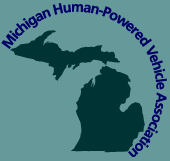 TERRY GERWECK and Morticia at the Oct. 30, 2010, Tombstone Derby in Elmore, Ohio. (All photos by Terry, except for this one, obviously.)
TERRY GERWECK and Morticia at the Oct. 30, 2010, Tombstone Derby in Elmore, Ohio. (All photos by Terry, except for this one, obviously.) The finished Morticia. Notice the background.
The finished Morticia. Notice the background.
By TERRY GERWECK - Monroe, Mich.
2010 has been a very active building year for me. I finished my city 'bent early in the year; a successful build in
that it meets all the goals I intended. (See "Terry Gerweck's new recumbent" article below from June 24, 2010)
After the Waterford HPV rally in June, where I was re-introduced to my "dark side" roots, I set out to build an idea that
had fermented in my brain for far too long. Beyond my need for human powered speed, there is always the desire for human powered fun and Morticia is the incarnation of my adolescent wish to own a hearse.
Morticia's beginnings were quite humble. An old adult trike, cut in half and stretched. Two Orange County Choppers bicycles for the rear rims, tires, fenders and a few miscellaneous parts. (The 16-inch rims were laced to the original trike hubs, with some help at Jack's Bicycles in Monroe.) Some muffler tubing and conduit, bits and pieces from a child hauling bike trailer, a futon, and what ever else was lurking in my garage that seemed to fit. Fire up the welder, grind judiciously, shake a couple cans of paint at it and you've got a bike. (The two curved tubes running to the head tube originally formed the canopy supports on the bike trailer; tubing from the futon furnished the "truck bed.")

I found a couple pictures of horse-drawn hearses and scaled them down to trike size. The hearse coach body was made from quarter-inch plywood and wood moldings. Added details like lanterns came from the garden department, trim pieces from auto and motorcycle sources, a purple funeral flag (from an undisclosed source,) the biggest ape hanger handlebars from the local bike shop and miscellaneous skulls and other semi-scary stuff from the dollar store.
I guess my favorite piece of fabrication is the brake disc. It would be an OK piece if I had used a lathe (I don't have one), but for making it in a vise and a drill press with a hack saw and a couple of files, I'm really proud of it. I'd be even prouder if it worked worth a damn.


The brake disc hub came from a piece of aluminum bar and a chunk of aluminum plate was used for the disc itself. The axle is a single full width bar. The drive wheel bolts to one end and the other wheel freewheels on a set of bearings. The whole axle slides out of the frame and the brake disc, drive cog (and eventually, maybe a pulley for an electric drive) slide on to it in the middle of the axle frame work.
But the caliper brakes with stock bicycle brake pads don't develop a great deal of braking power. The 3,500 mm (137.8 inches) brake cable probably doesn't help much either. The brake cable was a stock item, also from Jack's, and is the longest stock cable I've ever found.
Morticia's public debut came Oct. 30 at the Tombstone Derby in Elmore, Ohio, southeast of Toledo. The mayor of Elmore welcomed Morticia and me, thanked me for coming out and sort of suggested he wouldn't be opposed to a human powered addition to his festival, so there could be a freak bike event as part of next year's Tombstone Derby.
Elmore is on the west end of the North Coast Inland Trail System (at least a 69-mile chunk of it, which is prime for a ride. The Tombstone Derby includes casket races and a parade. There's plenty of room and semi-demented spectators, perfect for a
pseudo bike show all contained within a loosely organized festival.
Opportunity abounds to do it right.
Morticia isn't done yet, there are so many details that can be added. I guess she'll be finished when I move on to the next build.
 Almost ready for painting. The two curved tubes running to the head tube originally formed the canopy supports on a bicycle trailer for transporting children.
Almost ready for painting. The two curved tubes running to the head tube originally formed the canopy supports on a bicycle trailer for transporting children. One use for an old futon
One use for an old futon












